Contribution to the fauna of langbian plateau, Southern Vietnam: Amphibians and reptiles of Hon Ba nature reserve (Khanh Hoa province)
During the recent years, the Plateau Langbian (Da Lat Plateau), which is
located at the southernmost extremity of the Truong Son mountain ridge, became an
important ground for herpetological studies. This exceptional mountainous plateau
encloses several conservation areas, such as Bidoup-Nui Ba National Park, Chu
Yang Sin National Park (NP) and Hon Ba Nature Reserve (NR), represented by vast
massifs of montane forests which refuge a very rich fauna. A number of new species
of frogs and one new gecko were described from Langbian Plateau recently.
However, while more or less comprehensive herpetofaunistic reports are available
for Bidoup-Nui Ba NP (Paiarkov, Vasilieva, 2011) and Chu Yang Sin NP (Orlov et
al., 2008; BirdLife International, 2010), the data on amphibians and reptiles of Hon
Ba NR remain very fragmentary. Namely, they include the detailed inventory of
lizard fauna with some comments on snakes and turtles (Bobrov, 2006) and records
of some frog species (Nguyen et al., 2014; Vassilieva et al., 2014). At the same time,
the amphibian fauna of the Reserve deserves more attention because of its potential
richness and peculiarity: at least one species (Kalophrynus honbaensis) described
from Hon Ba (Vassilieva et al., 2014) can be currently considered as local endemic,
and several species are known to date only from Langbian Plateau.
Herein the preliminary data on amphibian and reptile fauna of Hon Ba Nature
Reserve are presented.
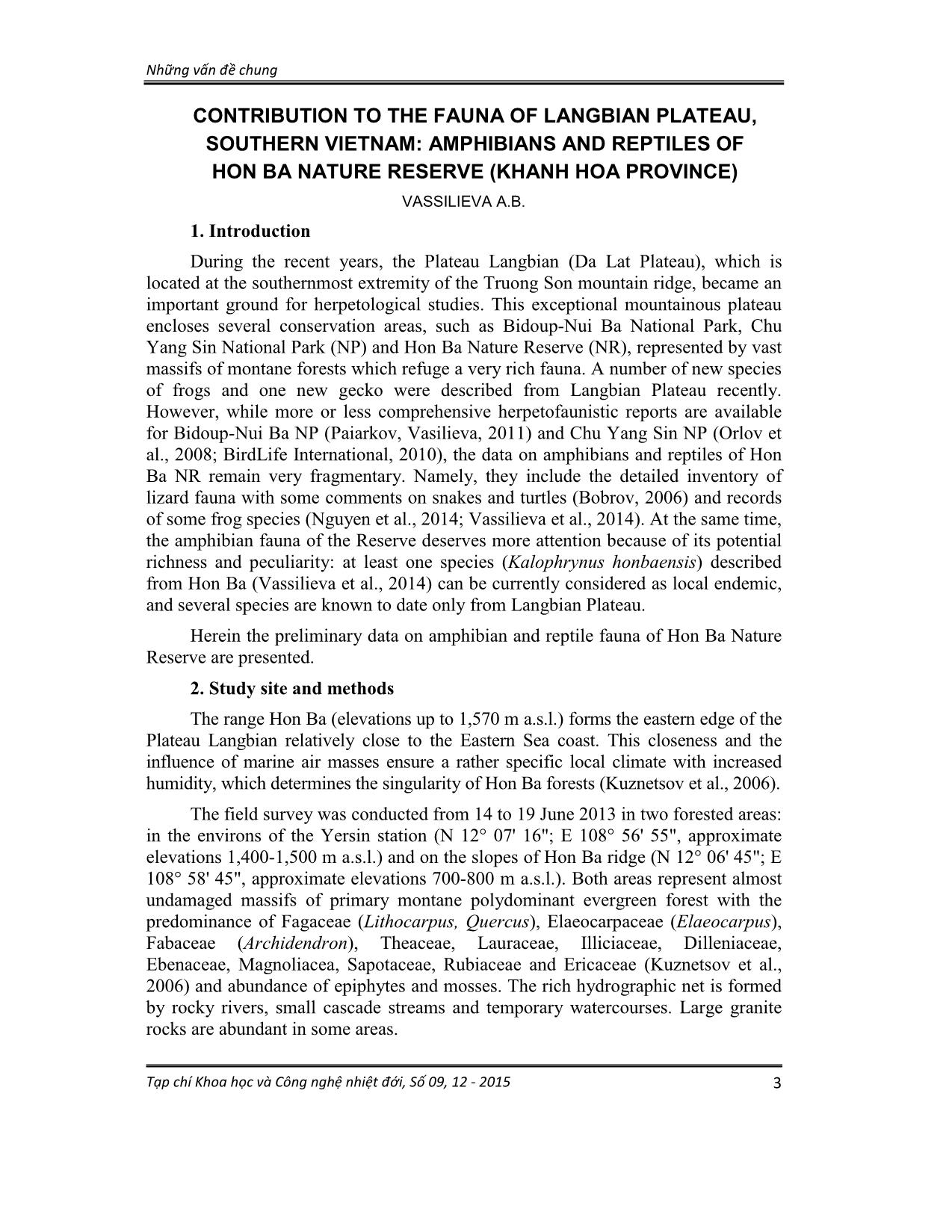
Trang 1
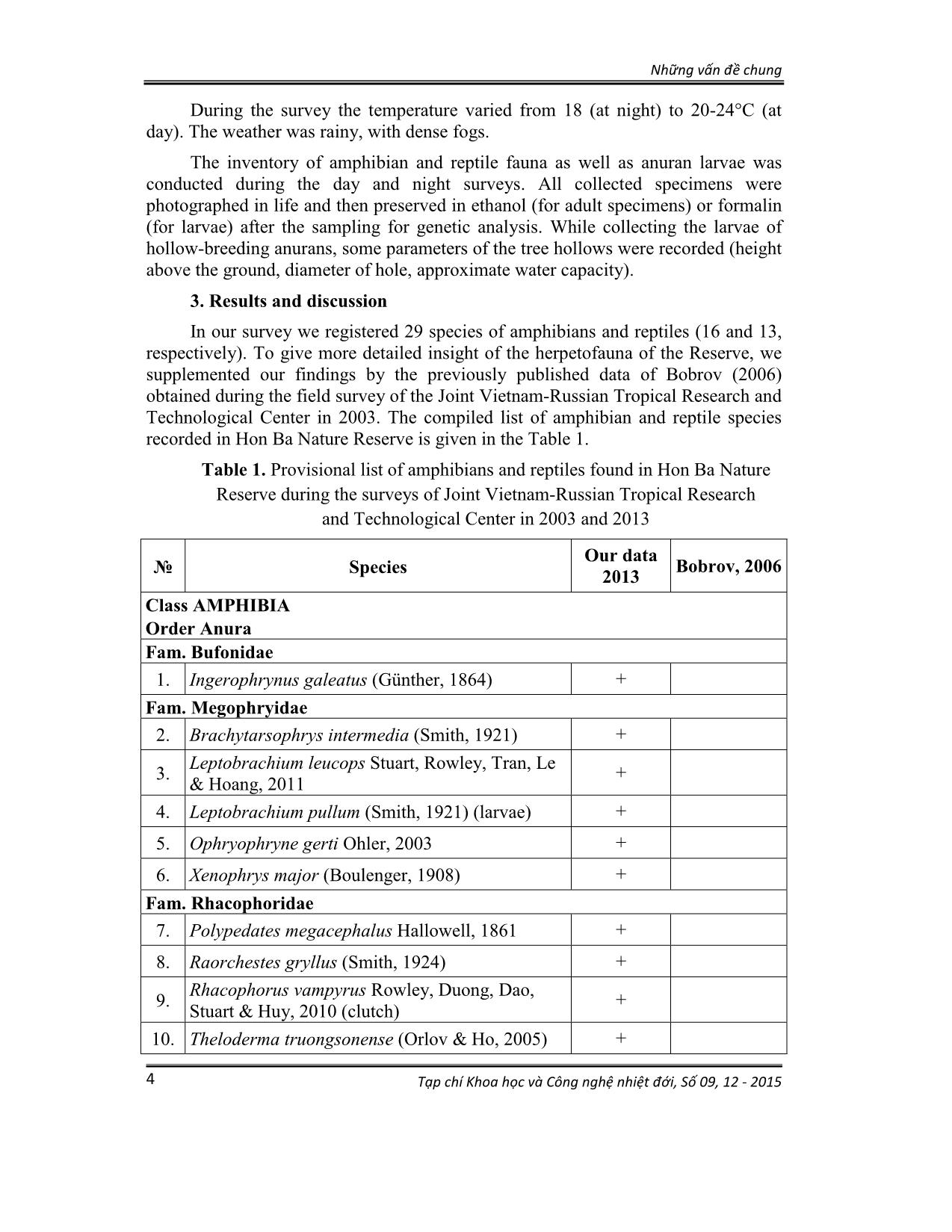
Trang 2
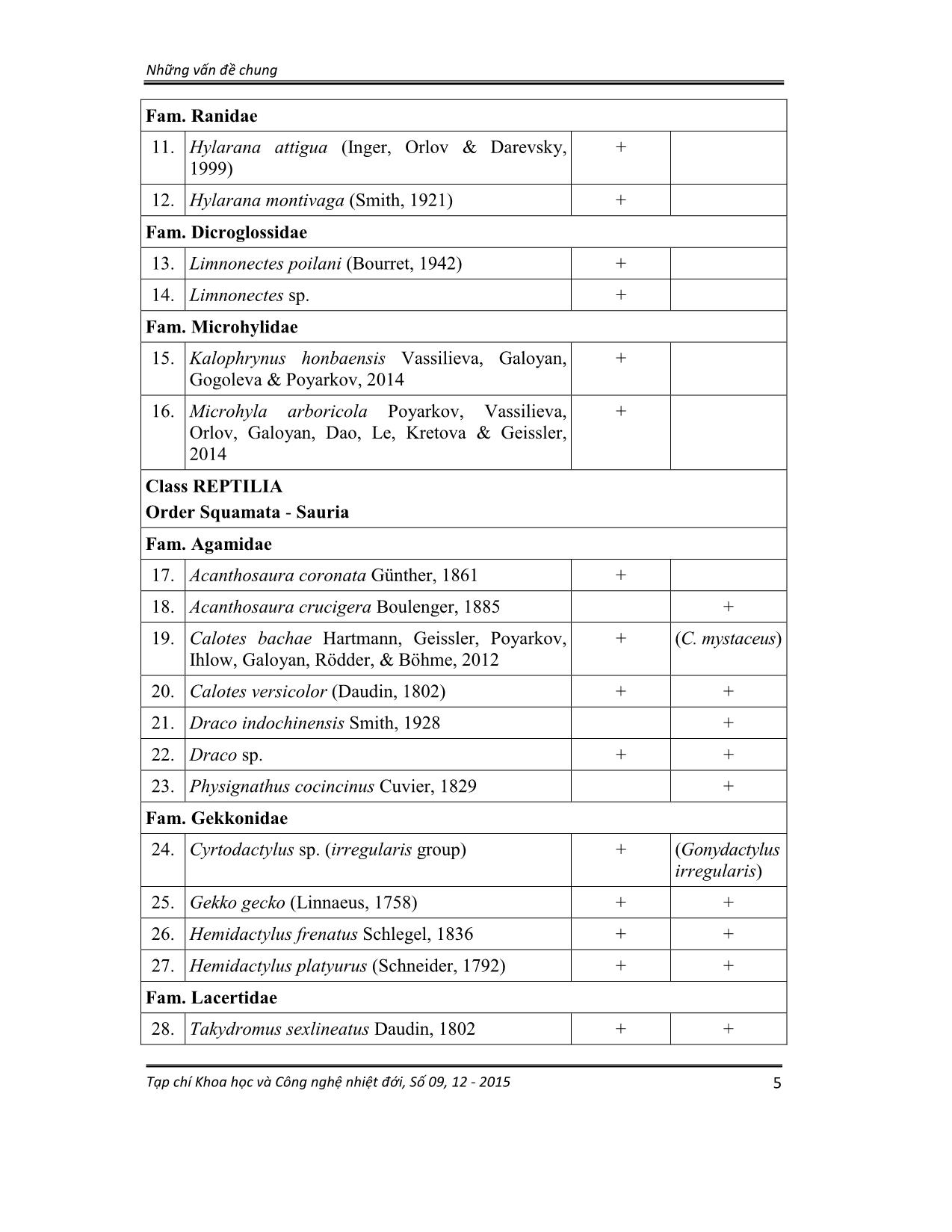
Trang 3
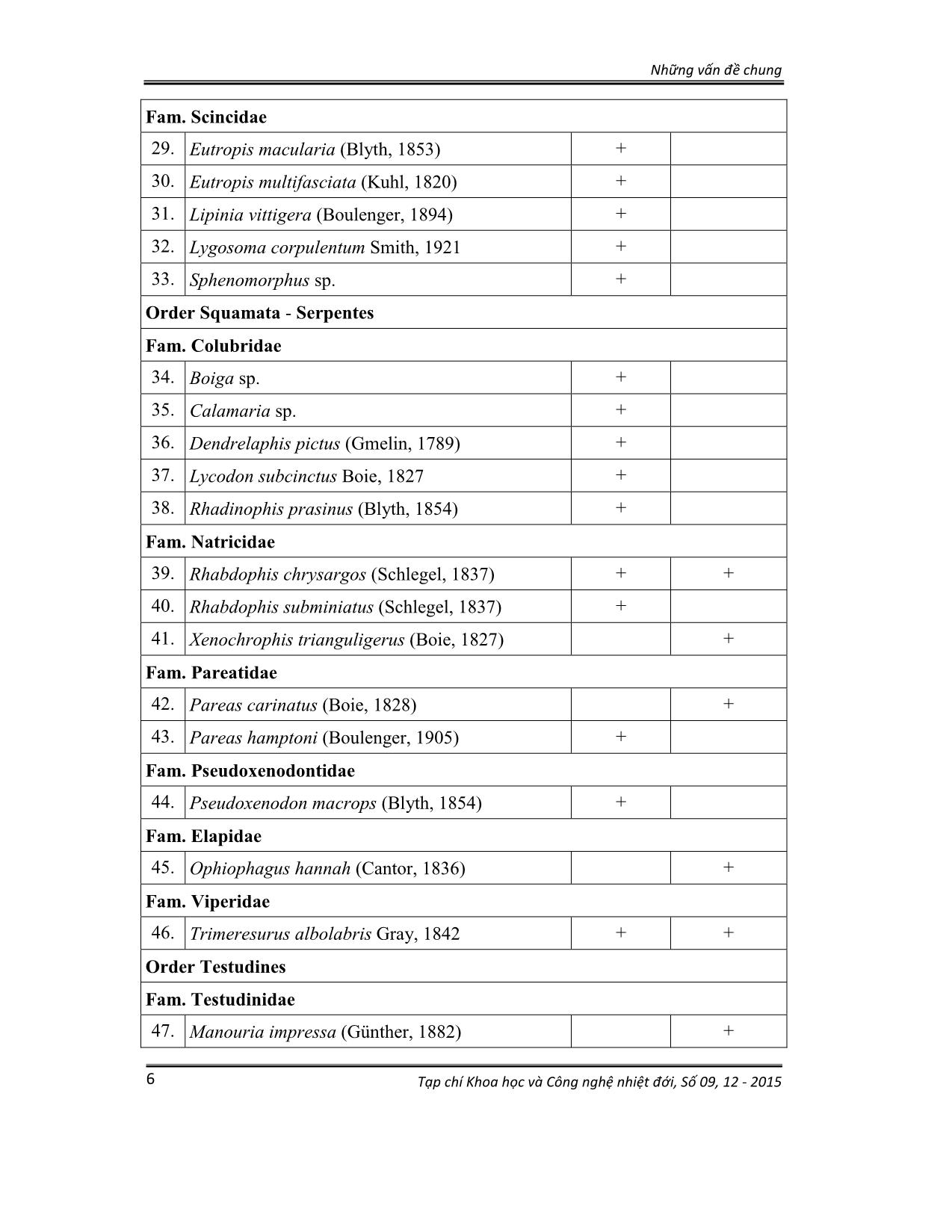
Trang 4
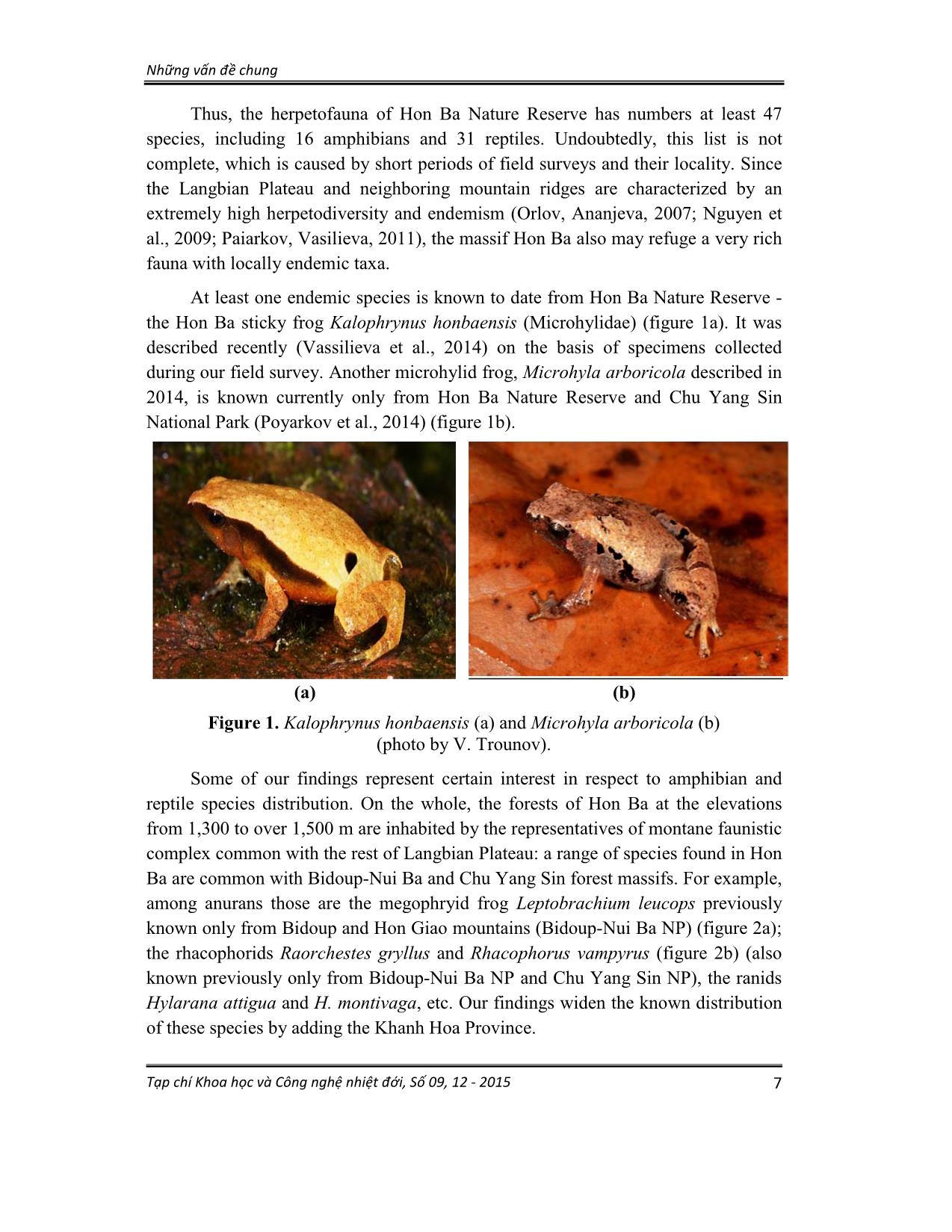
Trang 5
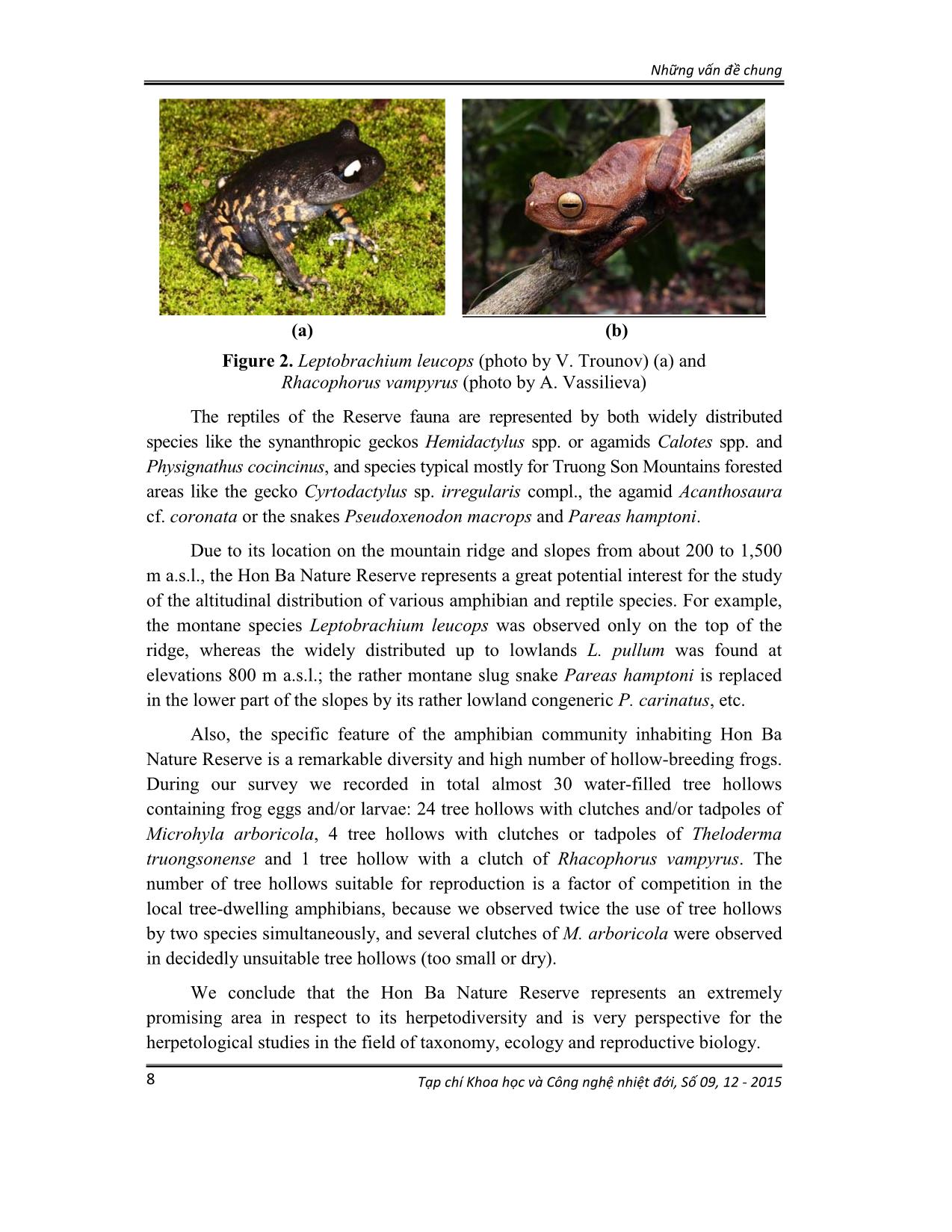
Trang 6
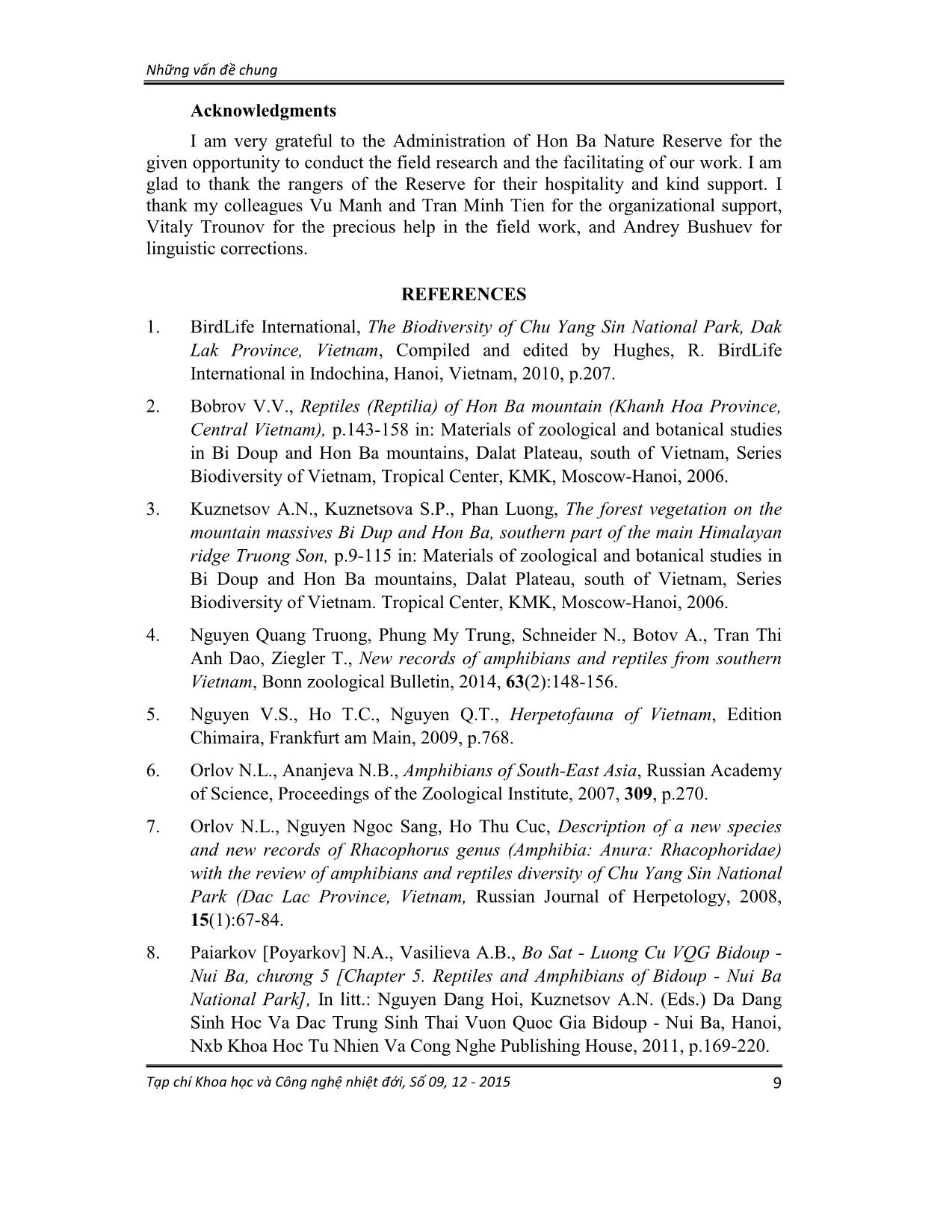
Trang 7
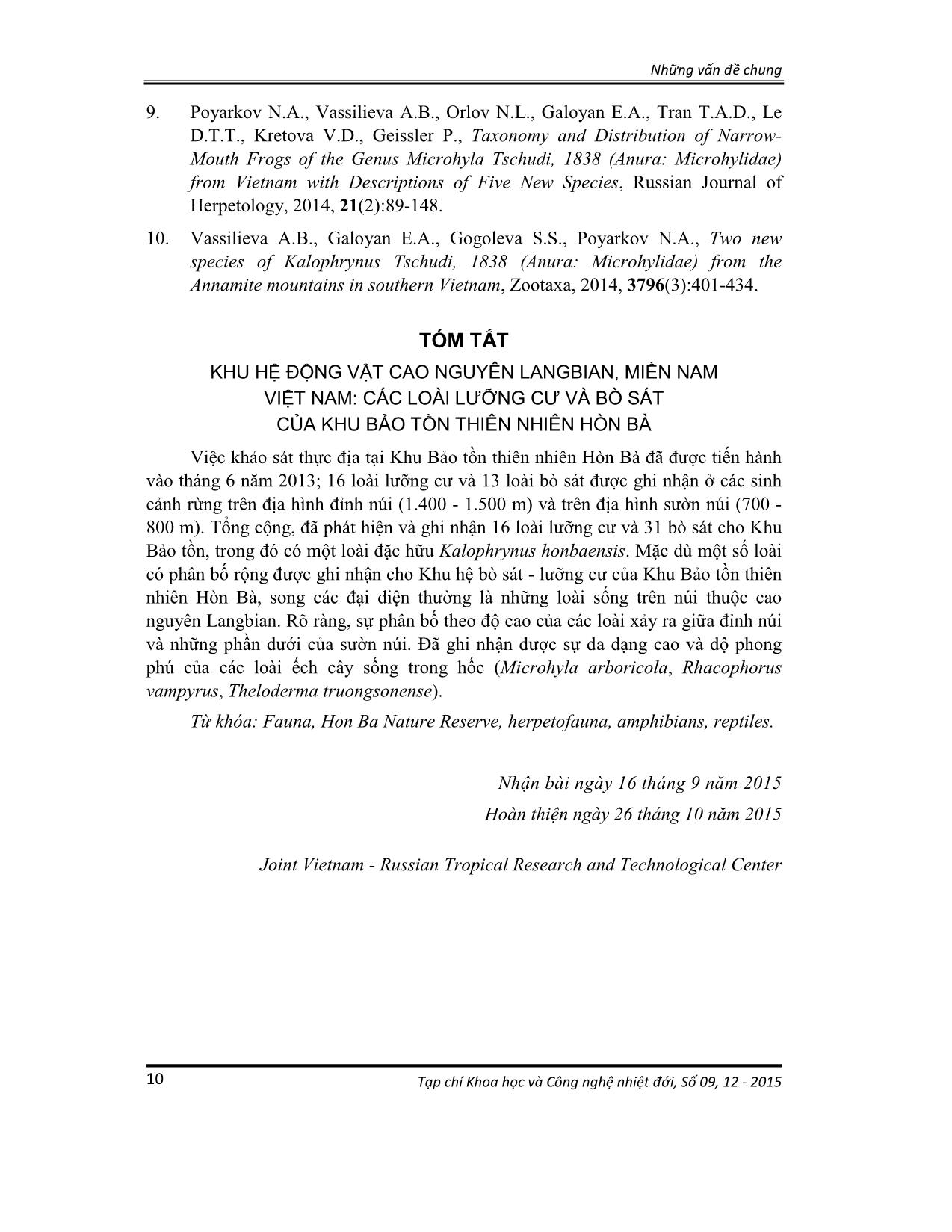
Trang 8
Tóm tắt nội dung tài liệu: Contribution to the fauna of langbian plateau, Southern Vietnam: Amphibians and reptiles of Hon Ba nature reserve (Khanh Hoa province)
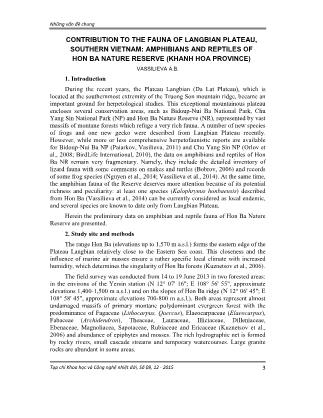
ng Sin NP (Orlov et al., 2008; BirdLife International, 2010), the data on amphibians and reptiles of Hon Ba NR remain very fragmentary. Namely, they include the detailed inventory of lizard fauna with some comments on snakes and turtles (Bobrov, 2006) and records of some frog species (Nguyen et al., 2014; Vassilieva et al., 2014). At the same time, the amphibian fauna of the Reserve deserves more attention because of its potential richness and peculiarity: at least one species (Kalophrynus honbaensis) described from Hon Ba (Vassilieva et al., 2014) can be currently considered as local endemic, and several species are known to date only from Langbian Plateau. Herein the preliminary data on amphibian and reptile fauna of Hon Ba Nature Reserve are presented. 2. Study site and methods The range Hon Ba (elevations up to 1,570 m a.s.l.) forms the eastern edge of the Plateau Langbian relatively close to the Eastern Sea coast. This closeness and the influence of marine air masses ensure a rather specific local climate with increased humidity, which determines the singularity of Hon Ba forests (Kuznetsov et al., 2006). The field survey was conducted from 14 to 19 June 2013 in two forested areas: in the environs of the Yersin station (N 12° 07' 16"; E 108° 56' 55", approximate elevations 1,400-1,500 m a.s.l.) and on the slopes of Hon Ba ridge (N 12° 06' 45"; E 108° 58' 45", approximate elevations 700-800 m a.s.l.). Both areas represent almost undamaged massifs of primary montane polydominant evergreen forest with the predominance of Fagaceae (Lithocarpus, Quercus), Elaeocarpaceae (Elaeocarpus), Fabaceae (Archidendron), Theaceae, Lauraceae, Illiciaceae, Dilleniaceae, Ebenaceae, Magnoliacea, Sapotaceae, Rubiaceae and Ericaceae (Kuznetsov et al., 2006) and abundance of epiphytes and mosses. The rich hydrographic net is formed by rocky rivers, small cascade streams and temporary watercourses. Large granite rocks are abundant in some areas. Những vấn đề chung Tạp chí Khoa học và Công nghệ nhiệt đới, Số 09, 12 - 2015 4 During the survey the temperature varied from 18 (at night) to 20-24°C (at day). The weather was rainy, with dense fogs. The inventory of amphibian and reptile fauna as well as anuran larvae was conducted during the day and night surveys. All collected specimens were photographed in life and then preserved in ethanol (for adult specimens) or formalin (for larvae) after the sampling for genetic analysis. While collecting the larvae of hollow-breeding anurans, some parameters of the tree hollows were recorded (height above the ground, diameter of hole, approximate water capacity). 3. Results and discussion In our survey we registered 29 species of amphibians and reptiles (16 and 13, respectively). To give more detailed insight of the herpetofauna of the Reserve, we supplemented our findings by the previously published data of Bobrov (2006) obtained during the field survey of the Joint Vietnam-Russian Tropical Research and Technological Center in 2003. The compiled list of amphibian and reptile species recorded in Hon Ba Nature Reserve is given in the Table 1. Table 1. Provisional list of amphibians and reptiles found in Hon Ba Nature Reserve during the surveys of Joint Vietnam-Russian Tropical Research and Technological Center in 2003 and 2013 № Species Our data 2013 Bobrov, 2006 Class AMPHIBIA Order Anura Fam. Bufonidae 1. Ingerophrynus galeatus (Günther, 1864) + Fam. Megophryidae 2. Brachytarsophrys intermedia (Smith, 1921) + 3. Leptobrachium leucops Stuart, Rowley, Tran, Le & Hoang, 2011 + 4. Leptobrachium pullum (Smith, 1921) (larvae) + 5. Ophryophryne gerti Ohler, 2003 + 6. Xenophrys major (Boulenger, 1908) + Fam. Rhacophoridae 7. Polypedates megacephalus Hallowell, 1861 + 8. Raorchestes gryllus (Smith, 1924) + 9. Rhacophorus vampyrus Rowley, Duong, Dao, Stuart & Huy, 2010 (clutch) + 10. Theloderma truongsonense (Orlov & Ho, 2005) + Những vấn đề chung Tạp chí Khoa học và Công nghệ nhiệt đới, Số 09, 12 - 2015 5 Fam. Ranidae 11. Hylarana attigua (Inger, Orlov & Darevsky, 1999) + 12. Hylarana montivaga (Smith, 1921) + Fam. Dicroglossidae 13. Limnonectes poilani (Bourret, 1942) + 14. Limnonectes sp. + Fam. Microhylidae 15. Kalophrynus honbaensis Vassilieva, Galoyan, Gogoleva & Poyarkov, 2014 + 16. Microhyla arboricola Poyarkov, Vassilieva, Orlov, Galoyan, Dao, Le, Kretova & Geissler, 2014 + Class REPTILIA Order Squamata - Sauria Fam. Agamidae 17. Acanthosaura coronata Günther, 1861 + 18. Acanthosaura crucigera Boulenger, 1885 + 19. Calotes bachae Hartmann, Geissler, Poyarkov, Ihlow, Galoyan, Rödder, & Böhme, 2012 + (C. mystaceus) 20. Calotes versicolor (Daudin, 1802) + + 21. Draco indochinensis Smith, 1928 + 22. Draco sp. + + 23. Physignathus cocincinus Cuvier, 1829 + Fam. Gekkonidae 24. Cyrtodactylus sp. (irregularis group) + (Gonydactylus irregularis) 25. Gekko gecko (Linnaeus, 1758) + + 26. Hemidactylus frenatus Schlegel, 1836 + + 27. Hemidactylus platyurus (Schneider, 1792) + + Fam. Lacertidae 28. Takydromus sexlineatus Daudin, 1802 + + Những vấn đề chung Tạp chí Khoa học và Công nghệ nhiệt đới, Số 09, 12 - 2015 6 Fam. Scincidae 29. Eutropis macularia (Blyth, 1853) + 30. Eutropis multifasciata (Kuhl, 1820) + 31. Lipinia vittigera (Boulenger, 1894) + 32. Lygosoma corpulentum Smith, 1921 + 33. Sphenomorphus sp. + Order Squamata - Serpentes Fam. Colubridae 34. Boiga sp. + 35. Calamaria sp. + 36. Dendrelaphis pictus (Gmelin, 1789) + 37. Lycodon subcinctus Boie, 1827 + 38. Rhadinophis prasinus (Blyth, 1854) + Fam. Natricidae 39. Rhabdophis chrysargos (Schlegel, 1837) + + 40. Rhabdophis subminiatus (Schlegel, 1837) + 41. Xenochrophis trianguligerus (Boie, 1827) + Fam. Pareatidae 42. Pareas carinatus (Boie, 1828) + 43. Pareas hamptoni (Boulenger, 1905) + Fam. Pseudoxenodontidae 44. Pseudoxenodon macrops (Blyth, 1854) + Fam. Elapidae 45. Ophiophagus hannah (Cantor, 1836) + Fam. Viperidae 46. Trimeresurus albolabris Gray, 1842 + + Order Testudines Fam. Testudinidae 47. Manouria impressa (Günther, 1882) + Những vấn đề chung Tạp chí Khoa học và Công nghệ nhiệt đới, Số 09, 12 - 2015 7 Thus, the herpetofauna of Hon Ba Nature Reserve has numbers at least 47 species, including 16 amphibians and 31 reptiles. Undoubtedly, this list is not complete, which is caused by short periods of field surveys and their locality. Since the Langbian Plateau and neighboring mountain ridges are characterized by an extremely high herpetodiversity and endemism (Orlov, Ananjeva, 2007; Nguyen et al., 2009; Paiarkov, Vasilieva, 2011), the massif Hon Ba also may refuge a very rich fauna with locally endemic taxa. At least one endemic species is known to date from Hon Ba Nature Reserve - the Hon Ba sticky frog Kalophrynus honbaensis (Microhylidae) (figure 1a). It was described recently (Vassilieva et al., 2014) on the basis of specimens collected during our field survey. Another microhylid frog, Microhyla arboricola described in 2014, is known currently only from Hon Ba Nature Reserve and Chu Yang Sin National Park (Poyarkov et al., 2014) (figure 1b). (a) (b) Figure 1. Kalophrynus honbaensis (a) and Microhyla arboricola (b) (photo by V. Trounov). Some of our findings represent certain interest in respect to amphibian and reptile species distribution. On the whole, the forests of Hon Ba at the elevations from 1,300 to over 1,500 m are inhabited by the representatives of montane faunistic complex common with the rest of Langbian Plateau: a range of species found in Hon Ba are common with Bidoup-Nui Ba and Chu Yang Sin forest massifs. For example, among anurans those are the megophryid frog Leptobrachium leucops previously known only from Bidoup and Hon Giao mountains (Bidoup-Nui Ba NP) (figure 2a); the rhacophorids Raorchestes gryllus and Rhacophorus vampyrus (figure 2b) (also known previously only from Bidoup-Nui Ba NP and Chu Yang Sin NP), the ranids Hylarana attigua and H. montivaga, etc. Our findings widen the known distribution of these species by adding the Khanh Hoa Province. Những vấn đề chung Tạp chí Khoa học và Công nghệ nhiệt đới, Số 09, 12 - 2015 8 (a) (b) Figure 2. Leptobrachium leucops (photo by V. Trounov) (a) and Rhacophorus vampyrus (photo by A. Vassilieva) The reptiles of the Reserve fauna are represented by both widely distributed species like the synanthropic geckos Hemidactylus spp. or agamids Calotes spp. and Physignathus cocincinus, and species typical mostly for Truong Son Mountains forested areas like the gecko Cyrtodactylus sp. irregularis compl., the agamid Acanthosaura cf. coronata or the snakes Pseudoxenodon macrops and Pareas hamptoni. Due to its location on the mountain ridge and slopes from about 200 to 1,500 m a.s.l., the Hon Ba Nature Reserve represents a great potential interest for the study of the altitudinal distribution of various amphibian and reptile species. For example, the montane species Leptobrachium leucops was observed only on the top of the ridge, whereas the widely distributed up to lowlands L. pullum was found at elevations 800 m a.s.l.; the rather montane slug snake Pareas hamptoni is replaced in the lower part of the slopes by its rather lowland congeneric P. carinatus, etc. Also, the specific feature of the amphibian community inhabiting Hon Ba Nature Reserve is a remarkable diversity and high number of hollow-breeding frogs. During our survey we recorded in total almost 30 water-filled tree hollows containing frog eggs and/or larvae: 24 tree hollows with clutches and/or tadpoles of Microhyla arboricola, 4 tree hollows with clutches or tadpoles of Theloderma truongsonense and 1 tree hollow with a clutch of Rhacophorus vampyrus. The number of tree hollows suitable for reproduction is a factor of competition in the local tree-dwelling amphibians, because we observed twice the use of tree hollows by two species simultaneously, and several clutches of M. arboricola were observed in decidedly unsuitable tree hollows (too small or dry). We conclude that the Hon Ba Nature Reserve represents an extremely promising area in respect to its herpetodiversity and is very perspective for the herpetological studies in the field of taxonomy, ecology and reproductive biology. Những vấn đề chung Tạp chí Khoa học và Công nghệ nhiệt đới, Số 09, 12 - 2015 9 Acknowledgments I am very grateful to the Administration of Hon Ba Nature Reserve for the given opportunity to conduct the field research and the facilitating of our work. I am glad to thank the rangers of the Reserve for their hospitality and kind support. I thank my colleagues Vu Manh and Tran Minh Tien for the organizational support, Vitaly Trounov for the precious help in the field work, and Andrey Bushuev for linguistic corrections. REFERENCES 1. BirdLife International, The Biodiversity of Chu Yang Sin National Park, Dak Lak Province, Vietnam, Compiled and edited by Hughes, R. BirdLife International in Indochina, Hanoi, Vietnam, 2010, p.207. 2. Bobrov V.V., Reptiles (Reptilia) of Hon Ba mountain (Khanh Hoa Province, Central Vietnam), p.143-158 in: Materials of zoological and botanical studies in Bi Doup and Hon Ba mountains, Dalat Plateau, south of Vietnam, Series Biodiversity of Vietnam, Tropical Center, KMK, Moscow-Hanoi, 2006. 3. Kuznetsov A.N., Kuznetsova S.P., Phan Luong, The forest vegetation on the mountain massives Bi Dup and Hon Ba, southern part of the main Himalayan ridge Truong Son, p.9-115 in: Materials of zoological and botanical studies in Bi Doup and Hon Ba mountains, Dalat Plateau, south of Vietnam, Series Biodiversity of Vietnam. Tropical Center, KMK, Moscow-Hanoi, 2006. 4. Nguyen Quang Truong, Phung My Trung, Schneider N., Botov A., Tran Thi Anh Dao, Ziegler T., New records of amphibians and reptiles from southern Vietnam, Bonn zoological Bulletin, 2014, 63(2):148-156. 5. Nguyen V.S., Ho T.C., Nguyen Q.T., Herpetofauna of Vietnam, Edition Chimaira, Frankfurt am Main, 2009, p.768. 6. Orlov N.L., Ananjeva N.B., Amphibians of South-East Asia, Russian Academy of Science, Proceedings of the Zoological Institute, 2007, 309, p.270. 7. Orlov N.L., Nguyen Ngoc Sang, Ho Thu Cuc, Description of a new species and new records of Rhacophorus genus (Amphibia: Anura: Rhacophoridae) with the review of amphibians and reptiles diversity of Chu Yang Sin National Park (Dac Lac Province, Vietnam, Russian Journal of Herpetology, 2008, 15(1):67-84. 8. Paiarkov [Poyarkov] N.A., Vasilieva A.B., Bo Sat - Luong Cu VQG Bidoup - Nui Ba, chương 5 [Chapter 5. Reptiles and Amphibians of Bidoup - Nui Ba National Park], In litt.: Nguyen Dang Hoi, Kuznetsov A.N. (Eds.) Da Dang Sinh Hoc Va Dac Trung Sinh Thai Vuon Quoc Gia Bidoup - Nui Ba, Hanoi, Nxb Khoa Hoc Tu Nhien Va Cong Nghe Publishing House, 2011, p.169-220. Những vấn đề chung Tạp chí Khoa học và Công nghệ nhiệt đới, Số 09, 12 - 2015 10 9. Poyarkov N.A., Vassilieva A.B., Orlov N.L., Galoyan E.A., Tran T.A.D., Le D.T.T., Kretova V.D., Geissler P., Taxonomy and Distribution of Narrow- Mouth Frogs of the Genus Microhyla Tschudi, 1838 (Anura: Microhylidae) from Vietnam with Descriptions of Five New Species, Russian Journal of Herpetology, 2014, 21(2):89-148. 10. Vassilieva A.B., Galoyan E.A., Gogoleva S.S., Poyarkov N.A., Two new species of Kalophrynus Tschudi, 1838 (Anura: Microhylidae) from the Annamite mountains in southern Vietnam, Zootaxa, 2014, 3796(3):401-434. TÓM TẮT KHU HỆ ĐỘNG VẬT CAO NGUYÊN LANGBIAN, MIỀN NAM VIỆT NAM: CÁC LOÀI LƯỠNG CƯ VÀ BÒ SÁT CỦA KHU BẢO TỒN THIÊN NHIÊN HÒN BÀ Việc khảo sát thực địa tại Khu Bảo tồn thiên nhiên Hòn Bà đã được tiến hành vào tháng 6 năm 2013; 16 loài lưỡng cư và 13 loài bò sát được ghi nhận ở các sinh cảnh rừng trên địa hình đỉnh núi (1.400 - 1.500 m) và trên địa hình sườn núi (700 - 800 m). Tổng cộng, đã phát hiện và ghi nhận 16 loài lưỡng cư và 31 bò sát cho Khu Bảo tồn, trong đó có một loài đặc hữu Kalophrynus honbaensis. Mặc dù một số loài có phân bố rộng được ghi nhận cho Khu hệ bò sát - lưỡng cư của Khu Bảo tồn thiên nhiên Hòn Bà, song các đại diện thường là những loài sống trên núi thuộc cao nguyên Langbian. Rõ ràng, sự phân bố theo độ cao của các loài xảy ra giữa đỉnh núi và những phần dưới của sườn núi. Đã ghi nhận được sự đa dạng cao và độ phong phú của các loài ếch cây sống trong hốc (Microhyla arboricola, Rhacophorus vampyrus, Theloderma truongsonense). Từ khóa: Fauna, Hon Ba Nature Reserve, herpetofauna, amphibians, reptiles. Nhận bài ngày 16 tháng 9 năm 2015 Hoàn thiện ngày 26 tháng 10 năm 2015 Joint Vietnam - Russian Tropical Research and Technological Center
File đính kèm:
 contribution_to_the_fauna_of_langbian_plateau_southern_vietn.pdf
contribution_to_the_fauna_of_langbian_plateau_southern_vietn.pdf

